BY CHRIS SLAY
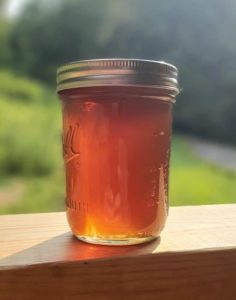 A quart of very fresh wildflower honey will taste like a sunny summer day all year long.
A quart of very fresh wildflower honey will taste like a sunny summer day all year long.
During the honey flow period, many established colonies made more honey than they need. In this four-part series, we’ll explore exactly what honey is, what differentiates some honey from others, traditional and modern medical uses, and the rich history humans have with honey as a food source. We’ll also disprove some common misconceptions about honey. Welcome back to the fascinating life cycle of the honey bee.
Honey begins as nectar from flowers. Worker bees collect nectar and pollen for food. The nectar that isn’t immediately consumed is stored in bees’ honey bellies and taken back to the hive. Honey bees’ salivary enzymes and proteins break down the nectar’s complex sucrose and starches into simple, more quickly digested sugars — glucose and fructose.
Because wild yeasts and bacteria can easily live on nectar, robbing its nutrients, honey bees reduce the nectar’s water content in two astonishing ways. First, they repeatedly regurgitate the nectar into their mandibles to create bubbles that provide a large surface area for water to evaporate. Second, after storing the partially dehydrated solution in open wax cells, groups of workers will constantly fan their wings, producing heat and airflow to reduce the water content even further. After the solution lowers to a water content of 18% to 15.5%, bees cap the cells with wax.
The nectar is now beyond the saturation point of water. This means there is far more sugar dissolved in what little water remains than ever could be dissolved in an equivalent volume of water.
For example, it’s impossible to dissolve one cup of sugar in seven teaspoons of water. This is honey.
Honey’s supersaturation of sugar is incredibly stable on molecular and chemical levels. Yeasts and bacteria are deterred from living on honey while in the capped cells, which ensures a very fresh and untainted food source.
The type of honey a colony produces depends entirely on the nectar’s primary source. Wildflower, the most abundant type of honey, is a combination of all of the thousands of different flowers from which the bees forage. Wildflower honey is typically light to dark amber in color and can have a very complex, multi-faceted taste. Other local nectar sources, such as basswood, tulip poplar, and sourwood trees, produce a much lighter-tasting, grassy-golden honey. Regardless of what the label says, no one knows what other flowers’ nectars are present without microscopically identifying the unique pollen cells in honey. Bees don’t discriminate.
At retail, honey is offered in many forms, but it’s either raw or processed. Most commercially produced honey is pasteurized, which ensures bacterial decontamination that may occur after uncapping the cells for extraction and the packaging process. Raising the temperature of honey above 104F also diminishes many of the unique qualities of honey. If you’ve ever had milk fresh from the cow, you understand. Commercial honey may also contain additives like high-fructose corn syrup or artificial coloring.
We are here to share current happenings in the bee industry. Bee Culture gathers and shares articles published by outside sources. For more information about this specific article, please visit the original publish source: All about honey – part 1 | Community News | thetomahawk.com
]]>Insects use the same types of non-hexagonal cells to overcome building challenges
AUBURN UNIVERSITY COLLEGE OF SCIENCES AND MATHEMATICS
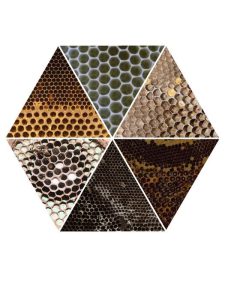
IMAGE: PHOTO CREDIT: MICHAEL L. SMITH
At first glance, the hexagonal cells build by honey bees and social wasps may seem similar, but they are significantly different. Honey bees build using wax, whereas wasps use paper. Honey bees build their double-sided combs vertically, whereas wasps build single-sided comb horizontally (i.e., the opening of each cell faces downward).
Indeed, the hexagonal cells built by these two groups have independent evolutionary origins. Just like sharks and whales have similar body plans due to their watery environment, bees and wasps build hexagonal cells because the shape maximizes strength and storage area, while minimizing building materials.
But what happens when perfectly hexagonal cells cannot be built? Do bees and wasps fix their building problems in the same way?
In a subset of honey bee and wasp species, workers build two different sizes of hexagons. The smaller cells are used for rearing workers, and the larger cells are used for rearing reproductives; drones and queens. This difference in cell sizes creates an inherent architectural problem: how do you tile two differently-sized hexagons within a single sheet of comb?
To determine how different species solved the same architectural problem, the researchers needed nest images that included both worker and reproductive cells in the same comb.
First-author Dr. Michael L. Smith, Assistant Professor in the Department of Biological Sciences at Auburn University, and Affiliate Member of the Max Planck Institute for Animal Behavior, contacted researchers across the globe for potential images. They then used custom-built software to extract per-cell metrics from 22,745 individual cells.
In some species, like Metapolybia mesoamerica, worker and reproductive cells are the same size, so there was no architectural hurdle to overcome. In other species, like Apis andreniformis, reproductive cells are up to 2.7 times larger than worker cells, which creates a serious building problem – how to combine these wildly different hexagons in an efficient way?
Looking across 10 species, the researchers found that as the scale of the building problem increased (the size difference between worker and reproductive cells), workers began incorporating non-hexagonal cells. These irregular cells were mostly 5- and 7-sided, but they were consistently built in pairs, with the 5-sided cell built on the worker-side, followed by a 7-sided cell on the reproductive side. This pattern was seen in all the honey bee and wasp species that had a cell-size difference to overcome. For a group of insects renowned for their hexagonal cells, this alone was interesting, as it showed that they all rely on the same non-hexagonal configurations.
The researchers then built a mathematical model that would predict, based on the cell-size difference, how many non-hexagonal cells should be incorporated into the worker-to-reproductive transition. Surprisingly, some of the species were consistently performing better than expected. Upon closer investigation, the researchers saw that these species also incorporated intermediate-sized cells into the transition region. The intermediate-sized cells were still hexagonal, but they allowed the insects to “split the difference” and turn the cell-size transition into a series of smaller ones, which didn’t require non-hexagonal cells.
These same building tricks were adopted across all species of bees and wasps investigated. Despite being separated by over 179 million years of evolution, using different building materials, and independent origins of hexagonal cells, these species have all arrived at the exact same solution to this scalable architectural problem.
“Once we were able to plot out all the data, the results were striking – you could see how the bees and wasps used intermediate-sized cells to make a gradual change, but also how consistently the non-hexagonal cells were arranged in the comb” said Michael L. Smith.
This work has implications for how collective systems can build adaptive and resilient structures without centralized control. There is no single bee or wasp “architect” building the entire structure, instead, it is hundreds or even thousands of individuals contributing to the final product.
This work, titled “Honey bees and social wasps reach convergent architectural solutions to nest-building problems,” was published 27 July 2023 in the journal PLOS Biology.
This study was funded by the National Science Foundation, the German Research Foundation, a Packard Fellowship for Science and Engineering, and GETTYLABS.
This manuscript is published in PLOS Biology and is freely available at the following link: http://journals.plos.org/plosbiology/article?id=10.1371/journal.pbio.3002211
We are here to share current happenings in the bee industry. Bee Culture gathers and shares articles published by outside sources. For more information about this specific article, please visit the original publish source: http://journals.plos.org/plosbiology/article?id=10.1371/journal.pbio.3002211
]]>Gary McDonald Business Editor

Some of the staff and pickers at work in the Gilpin farm in Armagh
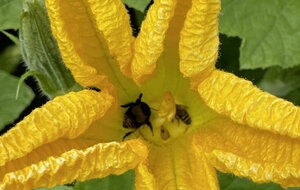
POLLINATOR: A bee inside a flower
NATURE – and the art of reproduction – is being given a helping hand in Co Armagh in a unique initiative where farmers are being assisted to track pollinators to maintain quality of produce and improve crop yields.
Retailer M&S is teaming up with agri-tech start-up AgriSound to provide in-field noise sensor technology to boost pollinator activity.
More than 70 per cent of the world’s food crops grown for human consumption rely on pollinators for sustained production, yield and quality.
And one of 18 sites across the UK chosen for the experiment is Gilpin Farms in Armagh, where sensors will be placed in its pumpkin patches.
Two in-field sensor trials were launched last year to help farmers better support pollinators like bumblebees and increase crop yields.
AgriSound technology allows farmers to track the number of pollinators visiting their farm in real-time and target specific interventions, like differing wildflower densities, for improving numbers and yields and quality of crops.
Now the technology is being scaled up across the UK to cover a diverse range of M&S’s fruit, veg and salad farms, with monitors covering 120 habitats and more than 1,000 hectares.
The technology will provide growers like Gilpins – which supplies M&S with carrots, leeks, pumpkins and Brussels sprouts – with access to real-time data and insights to help set their farms up to be more nature friendly.
Richard Gilpin, head of operations at Gilpin Farms, said: “The technology will be invaluable to help us monitor the pollinator activity across the whole farm, but particularly in the pumpkin crops.
“We currently bring in over 100 hives of bumble bees and honey bees to aid the pollination of the pumpkins, and the AgriSound technology will monitor how effective this is and also help us to make informed decisions about further interventions.
“We’re delighted to have been selected by M&S as one of the locations for this expansion and are excited to see what beneficial outcomes can be achieved by these relatively simple measures.
“If we can attract more pollinators to our farm, this will be a huge success.”
Andrew Clappen, technical director at M&S Food, added: “Improving biodiversity is at the forefront of our plans to help farmers become more resilient to the impact of climate change.
“Pollinators are the unsung heroes of farming – helping to improve yields and quality while benefitting the wider environment.”
We are here to share current happenings in the bee industry. Bee Culture gathers and shares articles published by outside sources. For more information about this specific article, please visit the original publish source: How technology is giving nature – and pollinators – a helping hand in Armagh – The Irish News
]]>By Maiya Fleck
MANDAN, N.D. (KFYR) – For 18 consecutive years, North Dakota has ranked first in the nation for honey production, according to the USDA.
Though they are small in size, bees play a big role in food production, but populations are at risk.
These busy bees play a larger role than some might think. Honey bees are a vital part of our lives, and without them, the North Dakota economy, food production, and commercial goods would suffer.
Beekeeper Jess Gifford works with a colony of people for his company “Who’s Your Honey” in Mandan. Gifford said he’s passionate about doing his part to keep this country well-fed.
“I was told the other day a cantaloupe needs to be pollinated 14 times. So that means 14 visits to each flower just to produce,” said Gifford.
The USDA says honey bees alone pollinate 80 percent of flowering plants like sunflowers and 130 different types of fruits and vegetables.
April Johnson, an extension pollinator technician at NDSU, said bee populations nationwide have been dwindling for multiple reasons including colony collapse disorder, varroa mite infestations and habitat loss. Moving bees around the country can impact their immune systems and diet changes.
The decline of hives is always a worry for beekeepers like Gifford. He moves his bees to Louisiana and California during the winter months.
“These viruses have been so detrimental to us. We used to take the bees, 50 years ago, we would just leave them here and wrap them in insulation,” said Gifford.
He said the bees also boost the North Dakota economy by bringing beekeepers to the state.
“Two and a half million hives roughly go to California, but here there are eight hundred and some thousand hives, we are told by the state. They come here for the honey production and pollination, and we need the honey,” said Gifford.
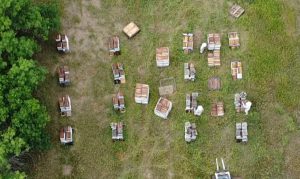
Bees at ‘Who’s Your Honey’ in Mandan(KFYR-TV)
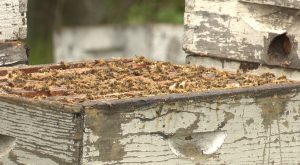
Beekeepers like Gifford have adapted and after two bad years, he feels 2023 is going to be a good year for production.
After the bees do their work on the prairie, he brings them back to the shop to collect honey and wax.
He uses the bees for honey, beeswax, pollen and also as pollinators in California.
North Dakota beekeepers produced 28.3 million pounds of honey in 2021, according to the USDA. There are many nationwide efforts for people to preserve bee populations like SaveTheBees.com.
We are here to share current happenings in the bee industry. Bee Culture gathers and shares articles published by outside sources. For more information about this specific article, please visit the original publish source: North Dakota honey bees are ‘buzzy’ playing a big role (kfyrtv.com)
]]>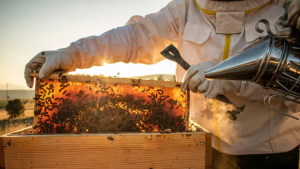
Honey bees are invaluable both for biodiversity and agriculture as they are excellent pollinators, yet their numbers worldwide have been dropping dramatically. The causes include climate change, habitat loss, pesticide use and diseases.
It is in this latter category of threats that entomologists from the University of Florida, the Agricultural Research Service-USDA, Louisiana State University and the University of Nebraska-Lincoln have made marked progress. They have done so by prompting honey bees’ cells to produce free radicals for protecting the insects against a range of potentially deadly viruses.
In field studies researchers used a compound called pinacidil to alter potassium ion channels, a protein found in the cells of bees’ and other iving things. Altering these channels produced slightly more free radicals, they explain.
The scientists gave the drug to honey bee colonies by mixing it into sugar water and drizzling it over their honey comb at night. The bees consumed the sugar water and also fed it to their young, thereby spreading the drug throughout the colony.
The treatment protected bees from six viruses that take their toll on honey bee colonies: Israeli acute paralysis virus, deformed wing viruses A and B, black queen cell virus, and Lake Sinai viruses 1 and 2.
“This approach is especially exciting because it doesn’t just target a specific type of virus but helps with many different viruses,” stresses Daniel Swale, an associate professor in the UF/IFAS entomology and nematology department.
“Additionally, we demonstrated that our treatment works both in the lab and in colonies that each contain 80,000 bees in the field,” he adds. “This is huge because in a hive setting bees are exposed to so many different viruses and stressors, so successfully controlling viruses in that environment is very encouraging.”
While viruses are not the greatest cause of deaths among bees, they can contribute significantly, according to the experts.
“Varroa mites are the number one cause of honey bee losses, but it’s important to point out that varroa mites, aside from physically weakening bees, also transmit viruses to bees. If we can mitigate viruses in honey bee colonies, that would be a big step forward,” says Michael Simone-Finstrom, a research molecular biologist with the ARS Honey Bee Breeding, Genetics, and Physiology Research Lab in Baton Rouge, Louisiana.
In their study the researchers also showed that pinacidil helped more bees survive in colonies infested with varroa mites.
Administering the drug to commercial honey bee hives may work only for some beekeepers as it is fairly expensive. However, this research shows the way in developing other drugs that cost less.
“One of the big take-aways from this study is that potassium ion channels can be a target for improving immune system function in honey bees and possibly other insects. We would like to find a molecule, such as a peptide, or a new technology that has the same effect as pinacidil but is more accessible to beekeepers,” Swale says.
We are here to share current happenings in the bee industry. Bee Culture gathers and shares articles published by outside sources. For more information about this specific article, please visit the original publish source: Scientists Develop a Drug to Protect Honey Bees from Viruses – The Good Men Project
]]>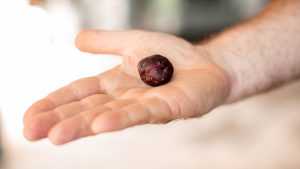
Propolis is a sticky resinous substance found in bee hives.
Beekeepers look to untapped potential of propolis, or ‘bee glue’, as alternative revenue stream
A by-product of honey production largely discarded in Australia could provide an alternative income source for beekeepers across the country.
Hidden within the walls of their hives, bees blend up a unique mix of materials that scientists believe holds untapped potential in Australia.
Propolis is a sticky, resinous substance that’s sometimes referred to as “bee glue”.
Bees use propolis as a powerful sterilising agent as well as to seal gaps in their hives against predators and the elements.
‘Propolis is used by the bees because they don’t have an immune system,” Queensland beekeeper Murray Arkadieff said.
“Bees forage within a 7 kilometre radius of the beehive, so that means they cover about 210km²,” he said.

Murray Arkadieff has been a beekeeper his entire life.
Mr Arkadieff said the bees were able to look throughout that 210km² and search for parts of plants that could be used to polish their hives.
The bees not only forage for nectar and pollen, but also for other parts of the natural environment such as sap or bark.
“They bring that back to the beehive and they can mix it all together and it turns it into a really strong antimicrobial, anti-fungal, antiviral and antibacterial material, which they polish their entire hive with,” he said.
Propolis and its medicinal wonders
Propolis also has benefits for people and is used in many different countries in medicines, dietary supplements, and cosmetics.
“Propolis contains high polyphenolic compounds,” organic chemist from the University of the Sunshine Coast Trong Tran said.
“Australian propolis is very diverse and it also shows very comparable, even higher antioxidant activities compared with the other well-known propolis in the world, Dr Tran said”
Despite being part of a well-established industry elsewhere, in Australia there isn’t large-scale commercial propolis harvesting and processing.
“We’ve always mainly been focused on liquid honey production,” Mr Arkadieff said.
“It’s not something that Australians have looked into in a massive way, which is why it’s such an exciting opportunity for the industry.”
Peter Brooks is part of the research team from the University of the Sunshine Coast that has been part of the Australian Propolis Project, an initiative supported by the federal government’s Agrifutures organisation.
“When we started talking to beekeepers about what they were interested in they were saying: ‘Well this propolis product that they throw out, it’s got a lot of value, so how could we use that in some of our research?” Dr Brooks said.
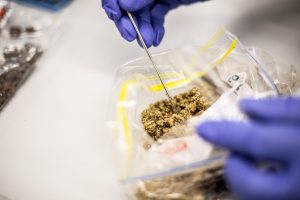
Samples of propolis were collected from different areas around the country and were sent to the lab to be analysed.
“Like everything, if you’re throwing something away that you could be making money for — it could be a new source of income.”
To begin with, scientists needed to ensure that Australian propolis was valuable, given its specific properties were largely unknown.
A buzzing opportunity for beekeepers
Hive and Wellness Australia, formerly known as Capilano, asked its 1,200 beekeepers nationally to consider participating in a trial collection of propolis.
Samples collected from all over the country were sent to the University of the Sunshine Coast for analysis.
“Of those samples that came back I think there was around 55 per cent that showed high antioxidant compounds,” said Jessica Berry, an industry liaison officer with Hive and Wellness Australia.
Dr Tran leads the research team, which is focused on finding out which samples hold the higher antioxidant value, and why.
He thinks one reason might be that about 80 per cent of Australia’s plants are endemic, and so aren’t found anywhere else.
“So we can expect that Australian propolis is unique to other areas in the world,” he said.
The complete article can be found at; https://www.abc.net.au/news/2023-07-23/australian-beehives-propolis-alternative-revenue-for-beekeepers/102625256o
We are here to share current happenings in the bee industry. Bee Culture gathers and shares articles published by outside sources. For more information about this specific article, please visit the original publish source: https://www.abc.net.au/news/2023-07-23/australian-beehives-propolis-alternative-revenue-for-beekeepers/102625256o
]]>Written by Jackie DiBartolomeo
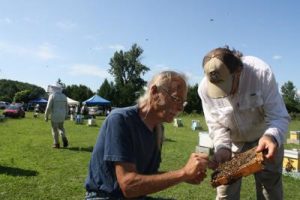
Mike Palmer searches for a queen bee with a partygoer July 19 in St. Albans. Jackie DiBartolomeo
FRANKLIN COUNTY — In a sunny field just off Kellogg Road in St. Albans, a group of 25 stood wearing an assortment of nets and hats. In their hands and swirling in the air around them were hundreds of bees.
The group gathered Wednesday morning to celebrate local and world-renowned beekeeper Mike Palmer. After buying his first two packs of bees back in 1974, Palmer is now in his 50th year of beekeeping. Over the decades, Palmer has become known internationally for his beekeeping methods with his brood of over 1,000 bee colonies.
Instead of gathering in a party hall to celebrate Palmer’s accomplishments, the group of beekeepers gathered in the place they and Palmer love best: a grassy field surrounded by the little yellow creatures that brought them all together in the first place.
When Palmer pulled up to the field to find 25 people waiting for him instead of the usual four or five, he was surprised and overwhelmed by the support.
“It means everything,” Palmer said. “It doesn’t feel like 50 years.”
Stationed at the 30-some hives placed throughout the field, partygoers took to searching for queen bees among the sticky honey and the dozens of bees attached to each frame.
With each queen found, the beekeepers carried her over to Palmer. Holding the queen in his hand with ease, Palmer took a dot of red paint to label her and put her in her own box, a throne of sorts. Guests watched on with each queen Palmer labeled, admiring his deftness with the small creatures.
Of the 1,200-some queen bees Palmer raises every summer, he sells half of them to beekeepers nationwide.
“This is my favorite thing to do…it’s nice to make nice honey, but it’s so much nicer to make nice queens and to send them all over the country,” Palmer said. “People write back, they call me on the phone; that, to me, is the reward.”
Guests at the party ranged from beekeepers who have been involved in the practice for decades, to amateurs. Yet with one guest qualifying herself as an “amateur” with eight years of experience, it is clear that learning is never really over in the beekeeping world…..
To read the Complete article go to; Local beekeepers catch queens for famed St. Albans beekeeper Mike Palmer’s 50th anniversary | Local News | samessenger.com
We are here to share current happenings in the bee industry. Bee Culture gathers and shares articles published by outside sources. For more information about this specific article, please visit the original publish source: Local beekeepers catch queens for famed St. Albans beekeeper Mike Palmer’s 50th anniversary | Local News | samessenger.com
]]> European foulbrood office hours webinar
European foulbrood office hours webinar
October 12, 2023 7:00PM – 8:30PM
This free webinar will be hosted on zoom. Register in advance. https://www.canr.msu.edu/events/european-foulbrood-office-hours-webinar
In this free evening webinar for beekeepers, Michigan State University honey bee disease experts will cover information on the honey bee disease European foulbrood (EFB). Dr. Meghan Milbrath and Dr. Peter Fowler will give a brief overview on how to recognize signs of this disease, perform diagnostic tests, and provide recommendations on what to do if you find it in your bee yard. We will highlight some recent research and give plenty of time for examples and questions.
https://www.canr.msu.edu/events/european-foulbrood-office-hours-webinar
The webinar will be recorded and posted on Michigan State University Beekeeping You Tube Channel: https://www.youtube.com/channel/UCD7AYI-MRu_3mp3oRW1kWVw/videos
When: Oct 12, 2023 19:00 Eastern Time (US and Canada)
Topic: European foulbrood Office Hours
Register in advance for this free webinar
Meghan Milbrath, MPH, PhD
517-884-9518
]]>PRESS RELEASE

Photo by Matthias Münning on Unsplash
According to HTF Market Intelligence, the Global Honey food market to witness a CAGR of 4.2% during forecast period of 2023-2028. The market is segmented by Global Honey Food Market Breakdown by Application (Food & Beverage, Pharmaceuticals, Others) by Type (Table Honey, Cooking Ingredient Honey) by Distribution Channel (Hypermarkets and Supermarkets, Convenience Stores, Specialty Stores, Others) by Packaging Type (Bottle, Jar, Tube, Tub, Others) and by Geography (North America, South America, Europe, Asia Pacific, MEA). The Honey food market size is estimated to increase by USD 2.6 Billion at a CAGR of 4.2% from 2023 to 2028. The report includes historic market data from 2017 to 2022E. Currently, market value is pegged at USD 8.9 Billion.
HTF Market Intelligence published a new research publication on Honey food Market Insights, to 2028″ with 150+pages and enriched with self-explained Tables and charts in presentable format. In the Study you will find new evolving Trends, Drivers, Restraints, Opportunities generated by targeting market associated stakeholders. The growth of the Honey food market was mainly driven by the increasing R&D spending across the world, however latest scenario and economic slowdown have changed complete market dynamics. Some of the key players profiled in the study are Barkman Honey, LLC (United States), Bee Maid Honey Limited (Canada), Billy Bee Honey Products Company (Canada), Capilano Honey Limited (Australia), Comvita Limited (New Zealand), Dabur India Limited (India), Dalian Sangdi Honeybee Co., Ltd. (China), Beeyond the Hive (United States), Lamex Foods (United States), Hi-Tech Natural Products (India).
Definition:
Honey foods are defined as foods that have some honey as an ingredient. By gathering nectar from flowers, honeybees create honey, a naturally sweet food. It is a natural phenomenon for honeybees to produce honey. The bees help store the honey as a food source in their wax honeycombs within beehives. Honey-containing foods are very effective in nature because they provide the meal a natural sweetness and protect consumers from artificial sweeteners. Consuming foods with honey in them can help fend against and treat diseases like cancer. A surge in consumer interest in consuming meals cooked with honey throughout the world is driving the market for honey-based cuisine.
We are here to share current happenings in the bee industry. Bee Culture gathers and shares articles published by outside sources. For more information about this specific article, please visit the original publish source: https://www.digitaljournal.com/pr/news/htf-market-intelligence/honey-food-market-will-witness-a-4-2-cagr-top-key-players-and-forecast-to-2028#ixzz880N3RpmC
]]>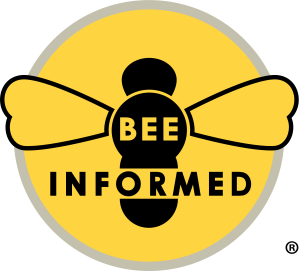 The Bee Informed Partnership (BIP) is pleased to announce the release of a new beekeeper management application that is a free version of its professional honey bee health and management tracking application at research.beeinformed.org!
The Bee Informed Partnership (BIP) is pleased to announce the release of a new beekeeper management application that is a free version of its professional honey bee health and management tracking application at research.beeinformed.org!
BIP ArcHive provides a seamless way for beekeepers to record activities and observations in the bee yard, giving insights to improve colony management.
- Map your bee yards
- Track the same colonies over time
- Record Varroa levels
- Mark conditions you observe in your colonies
- Curate a continuous history of honey bee health!
This new application called BIP ArcHive is based on the database and hive inspection procedures used by BIP Honey Bee Health Specialists in commercial operations since 2011. The application aids the beekeeper, inspector, or beekeeping consultant in keeping track of colony health and management actions over time. The free version, BIP ArcHive, is focused for individuals to track their own colonies and quickly view a timeline of management actions and varroa levels, enabling the beekeeper to better visualize their varroa levels in relation to management they do.
 BIP ArcHive home screen allows data entry and viewing a timeline of management applied and varroa levels. Access BIP ArcHive at https://research.beeinformed.org/bip-archive-free/
BIP ArcHive home screen allows data entry and viewing a timeline of management applied and varroa levels. Access BIP ArcHive at https://research.beeinformed.org/bip-archive-free/
A web version and mobile app is available for use while networked or remote, for both desktop and mobile use. A portion of BIP ArcHive development was sponsored by a USDA APHIS cooperative agreement and continues the tradition at BIP to enable citizen scientists and aspiring professional beekeepers to utilize technology and practices used by our Honey Bee Health Specialists and Technical Transfer team.
This and other BIP programs are made possible with the support of beekeepers like you. Please consider donating to support this and other beekeeper services.
Visit BIP’s website: https://beeinformed.org/
]]>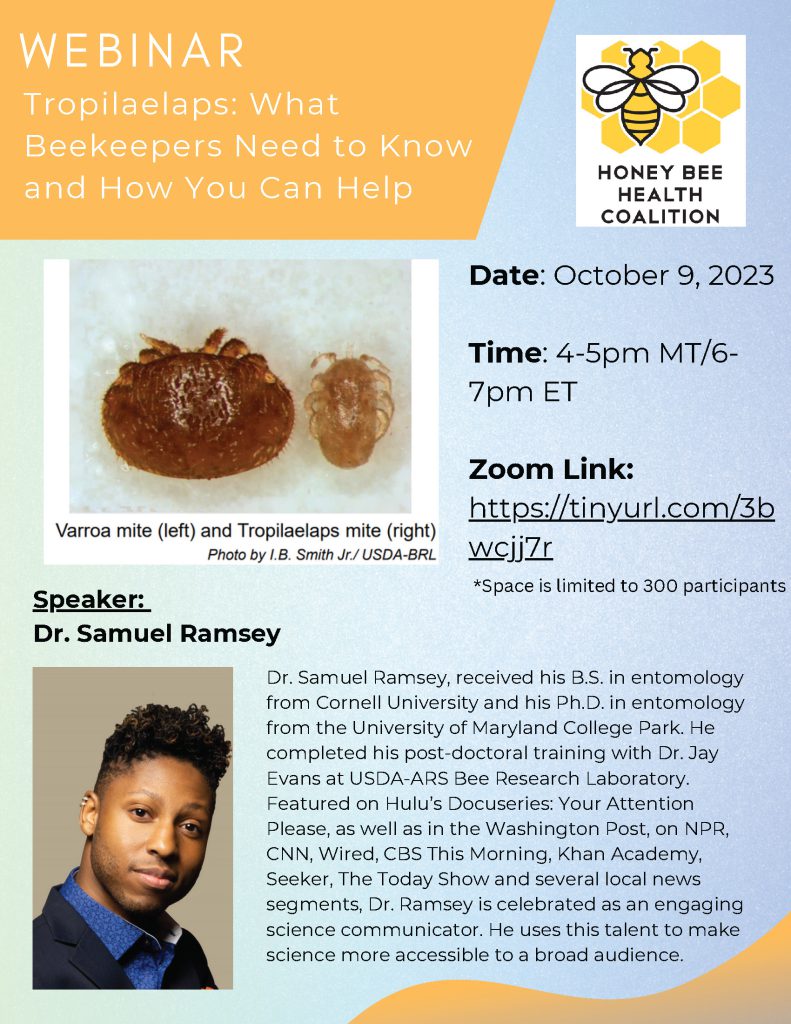
Link:
]]>The sweet stuff can help with burns, coughs, anxiety and more
By Alison Gwinn,
AARP
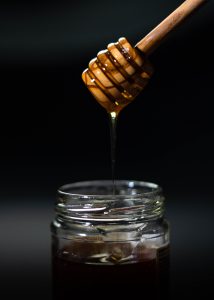
Photo by Daily Slowdown on Unsplash
Honey’s benefits have been touted since antiquity — and it turns out the ancient Greeks and Romans were onto something: Honey really can hit the sweet spot when it comes to our health.
Though honey — a sweet, sticky liquid made by honeybees from flower nectar — is technically a sugar, “it’s also really rich in a lot of different bioactive substances,” says Mayo Clinic registered dietitian (and hobbyist beekeeper) Joy Heimgartner. Those include a range of good-for-you minerals, probiotics, enzymes, antioxidants and other phytochemicals.
There are four common types of honey: Raw honey is defined by the National Honey Board as “honey as it exists in the beehive or as obtained by extraction, settling or straining without adding heat.” Manuka honey, produced from the flowers of manuka trees, is known for its unique antibacterial properties, attributed to a compound called methylglyoxal, says Jordan Hill, lead registered dietitian for Top Nutrition Coaching.
Organic honey is produced without the use of synthetic chemicals, pesticides or GMOs. And locally produced honey has been reported to provide relief from seasonal allergies to local pollen, though scientific evidence to support that claim is limited, says Hill.
According to Hill, honey can be substituted for sugar in recipes, but remember: It has a distinctive flavor (which varies depending on the source flowers); it’s sweeter than sugar (the general rule of thumb is to use ¾ to 1 cup of honey for every 1 cup of sugar); it’s a liquid, so you may need to cut back on other liquids or slightly increase the dry ingredients in a recipe; and it browns more quickly than sugar (so reduce the oven temperature by 25°F).
But whatever way you use honey — in a recipe or as a condiment — always keep in mind that it is a sweetener. “Honey is a supersaturated sugar solution, and we should limit added sugars of all types,” says Heimgartner. Still, “if you’re looking for a sweetener that has more to offer, honey is fantastic.” Here are six reasons why.
- Honey doesn’t raise your blood sugar as rapidly as white sugar
“Honey is metabolized differently from white sugar and produces less of a sugar spike,” says registered dietitian and nutritionist Dawn Jackson Blatner, author of The Flexitarian Diet. “Research suggests that honey may enhance insulin sensitivity and may support the pancreas, the organ that produces insulin.” A 2018 review of preliminary studies points to honey’s “hypoglycemic effect” and use as a “novel antidiabetic agent that might be of potential significance for the management of diabetes and its complications.”
And a 2022 study out of the University of Toronto found that honey improves important measures of cardiometabolic health, including blood sugar, cholesterol and triglyceride levels, especially if the honey is raw and from a single source.
- Honey can help with wound or burn therapy
“Honey has been used for wound healing for centuries, and certain types of honey, like medical-grade honey, have shown potential in wound management due to their antimicrobial properties and ability to promote healing,” says Hill, who nonetheless advises consulting health care professionals for appropriate wound care. Heimgartner, a board-certified oncology specialist, says, “There’s actually a lot of evidence that using honey during oral cancer radiation treatment helps to prevent some of the nasty side effects of mucositis,” or inflammation of the mouth.
How does it work? “Research suggests that honey prevents or controls the growth of bacteria on the wound, helps to slough off dead tissue and microorganisms, and transports oxygen and nutrients into a wound for quicker healing,” says Blatner.
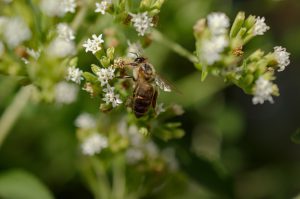
Native plants and naturalistic perennials attract bees and other pollinators.
Create Your Own Pollinator Garden
If you want to create your own pollinator garden for bees to forage in, consider these tips from Emily Erickson, postdoctoral researcher at the University of California, Davis, department of evolution and ecology.
- Opt for native plants or naturalistic perennials.
- Choose plants of varying colors, shapes and bloom times so you can support a variety of pollinators throughout the season.
- Avoid double-flowered varieties (those with extra petals) or plants that look drastically different from their wild relatives.
- Avoid pesticides.
- Leave areas in your yard that can serve as nesting habitats, such patches of bare soil, brush, twigs or woody stems, where many native pollinators make their homes.
- Which plants are right for you depends on your location and climate, so ask your local nursery for advice — or simply walk through a nursery and notice which plants seem to attract pollinators.
- Honey is rich in polyphenols, including flavonoids
Why does that matter? Because those two substances have both antioxidant and anti-inflammatory properties, meaning they protect our bodies against oxidative stress, which can manifest as cancer, heart disease or other diseases. But Hill cautions that the polyphenols in honeys can vary significantly, depending on the type of honey and its floral source.
- Honey can be an effective cough suppressant
A 2020 meta-analysis found that honey provides a widely available and inexpensive alternative to antibiotics in controlling cough frequency and severity, though it concluded that further studies were needed. “It is believed that honey’s thick texture and possible antioxidant and antimicrobial properties may provide relief for cough symptoms,” Hill says, but she adds the caveat that honey should never be given to infants under 1 year of age due to a risk of botulism.
- Honey may provide antidepressant or anti-anxiety benefits.
“Research suggests that polyphenol compounds in honey such as apigenin, caffeic acid, chrysin, ellagic acid and quercetin support a healthy nervous system, which may enhance memory and support mood,” says Blatner. Though more study is needed, a 2014 review of research says that one established nootropic (or cognitive-enhancing) property of honey “is that it assists the building and development of the entire central nervous system, particularly among newborn babies and preschool-age children, which leads to the improvement of memory and growth, a reduction of anxiety, and the enhancement of intellectual performance later in life.”
- Honey may support a healthy gut
Early research indicates that “honey has an extra-special ability to support a healthy gut microbiome because it contains both probiotics, or good bacteria, and prebiotic properties, which help good bacteria thrive,” says Blatner, though the evidence is limited. A 2022 paper funded by the National Institute of Health, Malaysia, concluded that “honey bees and honey, which have the potential to be good sources of probiotics and prebiotics, need to be given greater attention and more in-depth research so they can be taken to the next level.”
We are here to share current happenings in the bee industry. Bee Culture gathers and shares articles published by outside sources. For more information about this specific article, please visit the original publish source: https://www.aarp.org/health/healthy-living/info-2023/honey-health-benefits.html
]]>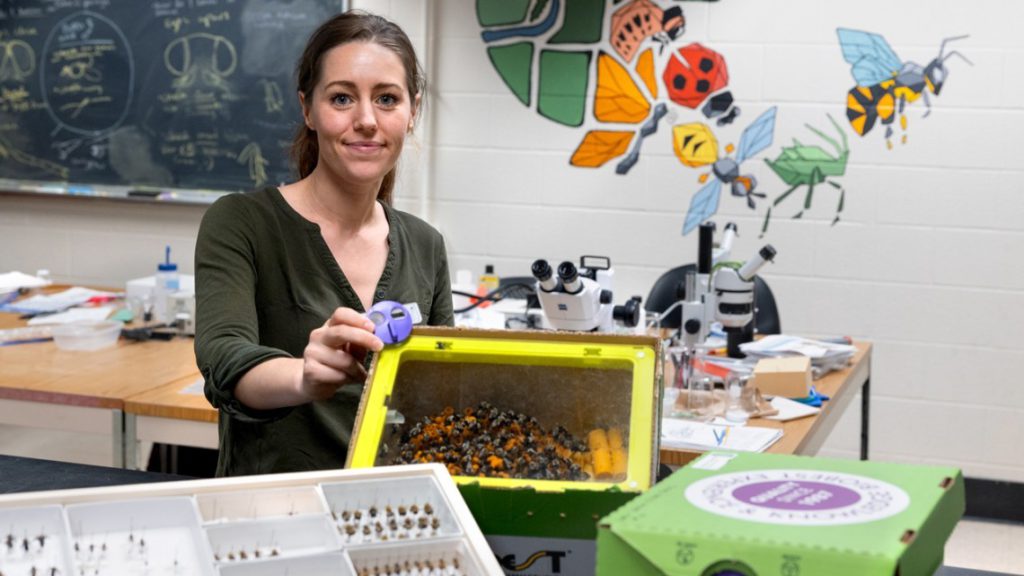
Credit:Ryan Young/Cornell University Researcher Heather Grab holds an excluder next to a commercial bumblebee nest box.
Bumblebee research sparks rapid industry change
By Krishna Ramanujan, Cornell Chronicle
A Cornell study that revealed commercial eastern common bumblebee hives pose a threat to their wild counterparts has led one major pollination company to quickly adapt the bumblebee hive boxes they ship to growers.
The study, which published in February in the Journal of Applied Ecology, showed that brightly colored commercial bumblebee nest boxes attract wild queens, who may be seeking to establish their own nests. When wild queens enter these nest boxes, workers treat them as invaders and kill them, which causes losses of wild hives – and valuable pollinators – in those areas.
The study also found that attaching an existing device – called an excluder – to the nest box doorways, was 100% effective at preventing wild queens from entering hives.
The company, Plant Products, a North American subsidiary of Biobest, has already provided excluders for the entrances and exits of all hives it ships, along with excluder operating instructions. In addition, a product manager has called every client to explain the use of the excluder, which makes a doorway too small for large queens, but big enough for workers.
“For every queen that we’re losing because of this behavior, that’s a whole colony of bumblebees that we’re potentially losing that’s providing really important pollination services later in the season,” said Heather Grab, Ph.D. ’17, senior lecturer in the School of Integrative Plant Science in the College of Agriculture and Life Sciences, and the paper’s corresponding author. Olivia Miller ‘21, who worked on this research as part of her undergraduate thesis, is the paper’s first author.
“From what we see in our data, it’s an average of about 10 queens per colony that are being killed, and that’s just in our study region,” she added.
The study also found that pollination services actually declined at sites where commercial bumblebee colonies were used, compared to areas where they were not used. The scientists suspect that the drop-in services was due to the loss of wild pollinators.
A few months prior to the paper’s publication, co-author Scott McArt, Ph.D. ’12, associate professor of pollinator health in the Department of Entomology (CALS) and manager of the Dyce Lab for Honeybee Studies, contacted Plant Products and Koppert, the only two North American commercial bumblebee suppliers, to tell them about their findings and how excluders offer a simple and effective solution. By the time the paper published in February, Plant Products was already prepared to add excluders to all its shipments. The company has also started research and development to evaluate optimal strategies going forward.
“Frankly, I’ve been blown away by how quickly Biobest responded to the study’s findings and implemented simple but effective companywide changes,” McArt said.
The excluders were originally developed for a completely different purpose, but came in handy when the Cornell researchers made their discovery. Commercial bumblebee nest boxes come with two openings, which serve as an entrance and an exit for the bees. The openings can be slid shut, so if growers spray their crops, they can close the exit to keep bees in but leave the entrance open for bees out foraging to return. Also, if growers want to move a hive, they can close both openings and reopen them in a new location.
Excluders were originally developed to cover just the exit, to prevent commercial hive queens from escaping and mating with wild bees and mixing genes, and/or spreading disease. No one expected they would be needed to keep wild bees out. Now Plant Products is using the excluders on both the entrances.
Overall, bumblebees have been experiencing population declines throughout North America, so saving queens early in spring has a high potential to stem some of those declines, McArt added.
Katja Poveda, associate professor of entomology in CALS, was also a co-author of the paper.
We are here to share current happenings in the bee industry. Bee Culture gathers and shares articles published by outside sources. For more information about this specific article, please visit the original publish source: Bumblebee research sparks rapid industry change | Cornell Chronicle
]]>Reuters
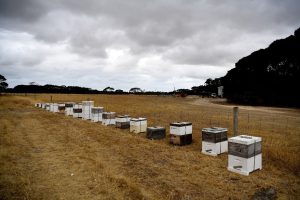
Bee hives at a farm on Kangaroo Island, Australia January 20, 2020. Picture taken January 20, 2020. REUTERS/Tracey Nearmy/File Photo
CANBERRA (Reuters) – The Australian government said it will stop trying to eradicate the Varroa mite, a parasite that kills honey bees, and will instead try to manage its spread, which is likely to make pollination of crops such as almonds more costly.
The decision ends an A$132 million ($85.3 million)eradication plan that has destroyed more than 14,000 hives in southeastern Australia since the mite was discovered there in June 2022.
The federal government said the decision was taken on Tuesday by the National Management Group (NMG), which is driving the Varroa programme nationwide.
In a statement on Wednesday, the New South Wales government, speaking on behalf of the NMG, said non-compliant and illegal movement of hives had spread the parasite further and made it impossible to contain.
Commercial crops including almonds, apples and avocados are dependent on pollination by European honey bees, with huge numbers of hives moved during spring flowering to bring bees to plants.
The Australian government has said a widespread mite infestation could destroy most wild European honey bee nests and managed hives not adapted to Varroa, reducing pollination and causing losses of over A$70 million a year.
“The recent spike in new detections have made it clear that the Varroa mite infestation is more widespread and has also been present for longer than first thought,” the New South Wales government said in a statement.
“The potential to eradicate is no longer possible… We now need to work collaboratively to manage and minimise the impact of Varroa.”
Varroa is a reddish-brown mite around 1 mm in diameter that attaches itself to European and Asian honey bees and feeds on them, weakening them and killing colonies.
The mite also carries viruses and has caused the collapse of honey bee populations around the world.
Varroa does not target native Australian honey bees.
We are here to share current happenings in the bee industry. Bee Culture gathers and shares articles published by outside sources. For more information about this specific article, please visit the original publish source: https://www.reuters.com/world/asia-pacific/australia-abandons-efforts-eradicate-deadly-honey-bee-parasite-2023-09-20/
]]>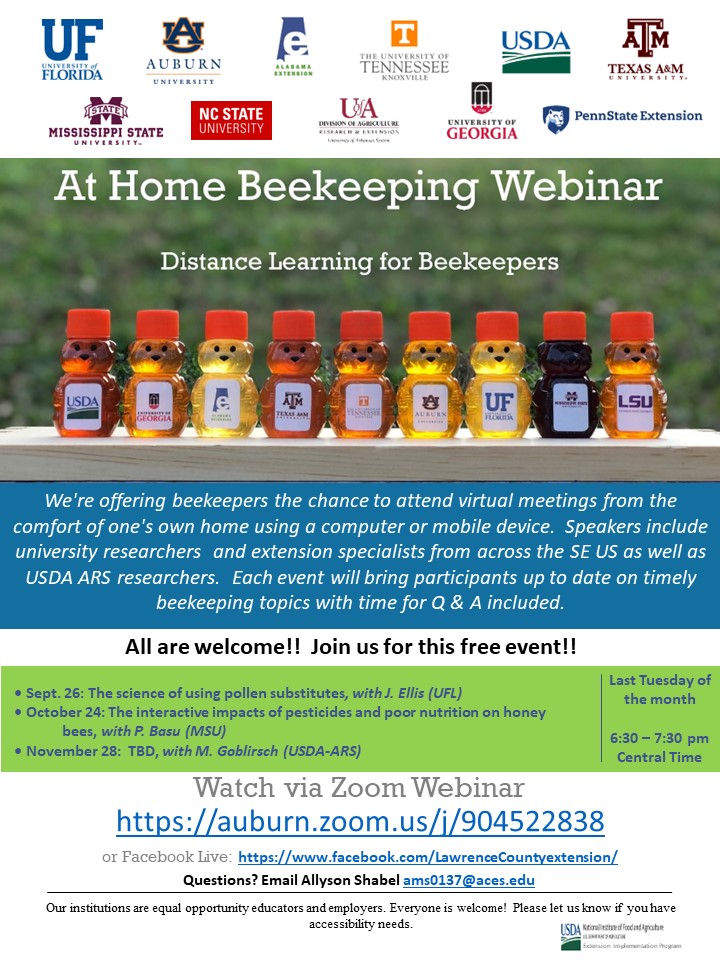
Links:
Zoom: https://auburn.zoom.us/j/904522838
]]>